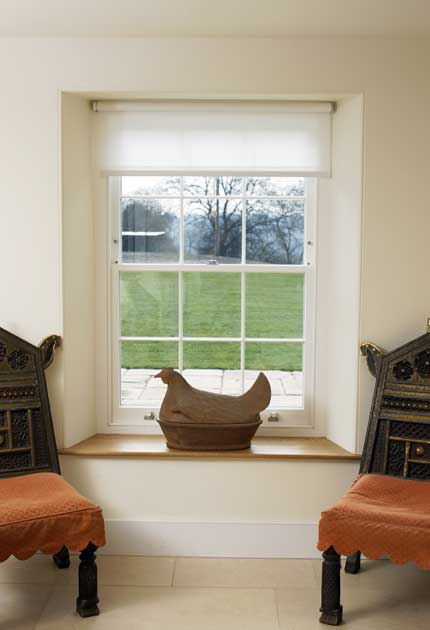Windows: How to transform your property
Bespoke timber frames not only revitalise period properties– adding style and environmental credentials – but can turn sterile modern buildings into homes with real character, says Jimmy Lee Shreeve

Your support helps us to tell the story
From reproductive rights to climate change to Big Tech, The Independent is on the ground when the story is developing. Whether it's investigating the financials of Elon Musk's pro-Trump PAC or producing our latest documentary, 'The A Word', which shines a light on the American women fighting for reproductive rights, we know how important it is to parse out the facts from the messaging.
At such a critical moment in US history, we need reporters on the ground. Your donation allows us to keep sending journalists to speak to both sides of the story.
The Independent is trusted by Americans across the entire political spectrum. And unlike many other quality news outlets, we choose not to lock Americans out of our reporting and analysis with paywalls. We believe quality journalism should be available to everyone, paid for by those who can afford it.
Your support makes all the difference.Windows are the "eyes" of a building. They play a big role in setting the character and charm of a house. If they're dilapidated and shabby, the whole place can look sad and uninviting. But if the window frames are tastefully stained or painted, a property will exude a stylish, welcoming atmosphere.
But just like our eyes, as windows get older, they need extra care and attention. Many Victorian and Edwardian town houses, for example, have rotting and draughty sash windows. And the metal window frames you still see in many 1920s and 1930s houses are typically held in place by rust, rather than metal.
In the 1960s, more than 95 per cent of window frames in Britain were made of wood. They needed regular maintenance to keep them looking good. But then came the great plastic revolution. Through the Sixties and Seventies, more homeowners opted to replace their windows with plastic – or uPVC (unplasticised polyvinylchloride) – units. They were hailed as the modern, maintenance-free way to keep heating bills down. You didn't need to sand and paint them. And they would supposedly last forever.
Since the mid-1980s, uPVC windows have overtaken wood – with timber now accounting for around 25 per cent of the 12 million windows sold each year in the UK. Plastic might be king. But many see it as tacky and wouldn't be seen dead with a uPVC window – even at the back of their house. Is this just style snobbery? Not according to Steve Hill, managing director of Birch Stone (birchstone.co.uk ), a joinery and building specialist in Kettering, Northants. He doesn't think uPVC windows are all they're cracked up to be.
"People think plastic lasts longer than timber and it's maintenance free," he says. "The truth is, after about 20 or 30 years, uPVC discolours and warps and the ironmongery wears out. Yet the wooden windows people are replacing have often been there 100 years."
Surely you've got the chore of painting or staining them every year? "That's another myth," says Hill. "We do a pre-finished, painted window with an eight-year guarantee on it – it's maintenance-free for nearly a decade."
In terms of cost, uPVC doesn't necessarily win over timber either. A 2005 report by the WWF collated various estimates of the relative costs of timber and plastic windows. It found that even high-spec timber windows should not cost more than uPVC. Case studies in the report show that timber-framed windows cost 15-25 per cent less than uPVC units taking the whole life of the products into account.
The WWF study found that timber is more environmentally friendly than uPVC if the timber comes from certified renewable sources. Not only are PVC windows made from oil (a non-renewable fossil fuel), but they use eight times more energy in their construction than timber windows and generate almost 50 per cent more waste.
But where timber truly wins out over plastic is when it comes to style. A wooden unit, tailored to the building, can transform even the most prosaic of properties. "By changing the style of the window, you can make a tremendous difference to the house," says Steve Hill. "You can turn a modern building into a house with character, or bring an older property back to its former glory. If you're planning to sell at some point, this can make a big difference in terms of marketability." If your windows are beginning to look a little ragged around the edges, they don't all have to be replaced. The Sash Window Workshop (sashwindow.com ) specialises in reconditioning old windows. Despite the downturn, demand is high. "There are an enormous number of timber windows in London in need of repair or replacement," says Richard Dollar, who runs the Berkshire-based firm. "It's a business sector that is relatively insulated."
Whatever type of replacements you go for, you will need Building Control approval. If you use a company registered with the Fenestration Self-Assessment Scheme (fensa.org.uk ), they will get the necessary certificate of compliance. Building regulations also stipulate that all windows, except those in conservation areas and listed buildings, must have a certain thermal efficiency value (a "U value") to reduce heat loss. The lower the U value, the better. Single glazing is 5.5, while standard double-glazing is around 1.8.
To really bring down the U value, it's worth getting double-glazing filled with argon gas. "It won't detract from the look of your windows," says Steve Hill. "But it can bring an 80 per cent increase in energy savings compared to single glazing, and a 45 per cent saving against ordinary double glazing."
Read more on windows prices
Join our commenting forum
Join thought-provoking conversations, follow other Independent readers and see their replies
Comments